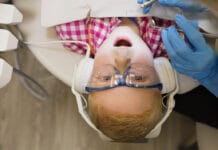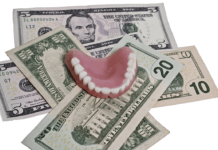1. Tooth avulsion occurs when trauma causes the tooth to be completely dislocated from the alveolar bone.
When the tooth is completely dislocated from the alveolar bone, it is referred to as tooth avulsion. Tooth avulsion of permanent teeth due to traumatic dental injuries is seen in 0.5% to 16% of dento-alveloar trauma.1,2
Studies indicate permanent tooth avulsion is one of the most serious dental injuries seen in dental settings, as the prognosis of treatment is highly dependent on actions taken immediately after the traumatic event.1
1. Fouad, A.F., Abbott, P.V., Tsilingaridis, G., et al. International Association of Dental Traumatology Guidelines for the Management of Traumatic Dental Injuries: 2. Avulsion of Permanent Teeth. Dent Traumatol. 2020; 36(4): 331-342. https://www.aapd.org/media/policies_guidelines/e_avulsion.pdf
2. Alotaibi, S., Haftel, A., Wagner, N.D. (2023, March 6). Avulsed Tooth. StatPearls. https://www.ncbi.nlm.nih.gov/books/NBK539876/
2. The peak incidence of dental trauma occurs in the seven to 11-year age group. Females are more likely to experience tooth avulsion with a female-to-male ratio of 2:1.
The peak incidence of dental trauma that could cause tooth avulsion is in the seven to 11-year age group. Males are at a higher risk of experiencing dental trauma and tooth avulsion, with a male-to-female ratio of 2:1.
The most common causes include falls, cycling, full-contact sports, traffic accidents, and assault. Certain anatomic features increase the risk of dental trauma, including protuberant maxillary anterior teeth, over 3 mm overjet, anterior open bite, malocclusion, and mouth breathing.
Alotaibi, S., Haftel, A., Wagner, N.D. (2023, March 6). Avulsed Tooth. StatPearls. https://www.ncbi.nlm.nih.gov/books/NBK539876/
3. First aid for avulsed permanent teeth includes all the following except which one?
First aid for avulsed permanent teeth at the place of the accident includes the following recommended instructions:1,2
- Keep the patient calm.
- Find the tooth and pick it up by the crown. Avoid touching the root.
- If the tooth is soiled, rinse it gently with milk, saline, or the patient’s saliva.
- Replant the tooth immediately at the accident site.
- Once the tooth has been replanted, the patient should bite on gauze, a handkerchief, or a napkin to hold it in place
- If replantation at the accident site is not possible, immediately place the tooth in a transport medium. Transport mediums in order of preference include milk, Hank’s Balanced Salt Solution, the patient’s saliva, or saline. Water is a poor choice, but it is better than no medium and can be used as a last resort.
- Bring the tooth and the patient to an emergency clinic.
- See a dentist or dental professional immediately.
1. Fouad, A.F., Abbott, P.V., Tsilingaridis, G., et al. International Association of Dental Traumatology Guidelines for the Management of Traumatic Dental Injuries: 2. Avulsion of Permanent Teeth. Dent Traumatol. 2020; 36(4): 331-342. https://www.aapd.org/media/policies_guidelines/e_avulsion.pdf
2. Alotaibi, S., Haftel, A., Wagner, N.D. (2023, March 6). Avulsed Tooth. StatPearls. https://www.ncbi.nlm.nih.gov/books/NBK539876/
4. Replanted teeth never require splinting because stabilizing the tooth is rarely a concern.
All replanted teeth require stabilization to maintain the correct position, provide patient comfort, and improve function.1 Splinting immobilizes the replanted tooth, allowing the damaged periodontal ligament fibers to reestablish connection from the cementum to the alveolus.2
After replantation, a splint should be placed for two weeks. When the splint is removed, the tooth should be clinically and radiographically examined to evaluate for mobility and pulp vitality. If the pulp is non-vital, root canal treatment is indicated.1,2
Clinical and radiographic monitoring should continue at four weeks, three months, six months, one year, and yearly for at least five years after replantation.1,2
1. Fouad, A.F., Abbott, P.V., Tsilingaridis, G., et al. International Association of Dental Traumatology Guidelines for the Management of Traumatic Dental Injuries: 2. Avulsion of Permanent Teeth. Dent Traumatol. 2020; 36(4): 331-342. https://www.aapd.org/media/policies_guidelines/e_avulsion.pdf
2. Alotaibi, S., Haftel, A., Wagner, N.D. (2023, March 6). Avulsed Tooth. StatPearls. https://www.ncbi.nlm.nih.gov/books/NBK539876/
5. Which of the following can be a complication associated with the replantation of avulsed teeth?
Major complications associated with replantation of avulsed teeth include:1,2
- Infections
- Tooth discoloration
- Fistulas
- Inflammatory root resorption
- Ankylosis
- Apical periodontitis
- Pulp canal obliteration
- Pulp necrosis
Resorption and ankylosis can potentially be mitigated by using a flexible splint rather than a rigid splint. Ankylosis is especially problematic in young patients undergoing facial development.1
In older patients, the major concern is the loss of tooth vitality. This is often due to the closed apex preventing revascularization. Favorable outcomes for a successful prognosis in closed apex cases include:1,2
- Asymptomatic
- Functional
- Normal mobility
- No sensitivity to percussion
- No radiolucency
- No root resorption
- Lamina dura appears normal
1. Alotaibi, S., Haftel, A., Wagner, N.D. (2023, March 6). Avulsed Tooth. StatPearls. https://www.ncbi.nlm.nih.gov/books/NBK539876/
2. Fouad, A.F., Abbott, P.V., Tsilingaridis, G., et al. International Association of Dental Traumatology Guidelines for the Management of Traumatic Dental Injuries: 2. Avulsion of Permanent Teeth. Dent Traumatol. 2020; 36(4): 331-342. https://www.aapd.org/media/policies_guidelines/e_avulsion.pdf
6. Tetanus is never a concern following dental trauma.
Though it is often assumed that patients are up to date on tetanus vaccinations, that may not always be the case. The adult vaccination rate for tetanus was found to be 62.9% in 2019, leaving more than a quarter of the adult U.S. population unprotected and vulnerable.1,2
Cases of tetanus acquired from oral lacerations have been reported in developed countries as recently as 2017. Though rare, it is imperative that dental professionals inquire about the status of tetanus vaccination in all trauma patients and refer them to a physician when indicated.3
1. Fouad, A.F., Abbott, P.V., Tsilingaridis, G., et al. International Association of Dental Traumatology Guidelines for the Management of Traumatic Dental Injuries: 2. Avulsion of Permanent Teeth. Dent Traumatol. 2020; 36(4): 331-342. https://www.aapd.org/media/policies_guidelines/e_avulsion.pdf
2. Jatlaoui, T.C., Hung, M. Srivastav, A., et al. (2024, July 22). Vaccination Coverage Among Adults in the United States, National Health Interview Survey, 2019-2020. Centers for Disease Control and Prevention. https://www.cdc.gov/adultvaxview/publications-resources/vaccination-coverage-adults-2019-2020.html
3. Fischer, B., Davis, B. (2017, June 5). Oral Injury as a Source of Tetanus Inoculation. Oral Health. https://www.oralhealthgroup.com/features/oral-injury-source-tetanus-inoculation/
7. Contact, collision, and high-velocity sports are strongly associated with _____ risk for dentofacial injury. The use of mouthguards has been found to contribute significantly to a _____ risk of dental trauma.
Contact, collision, and high-velocity sports are strongly associated with increased risk for dentofacial injury. In addition to contact, collision, and high-velocity sports, dental injuries are prevalent in limited-contact and non-contact sports. The use of mouthguards has been found to contribute significantly to a decreased risk of dental trauma.
It’s reported that the prevalence of dental trauma among mouthguard users is 7.5% to 7.75% compared to 48.31% to 59.98% among those who do not use mouthguards. Further, mouthguard users have been found to be 82% to 93% less likely to suffer dentofacial injuries. Coronal fractures and tooth avulsions are the most frequent injuries.
Athletic Mouth Protectors (Mouthguards). (2021, October 19). American Dental Association. https://www.ada.org/resources/ada-library/oral-health-topics/athletic-mouth-protectors-mouthguards








